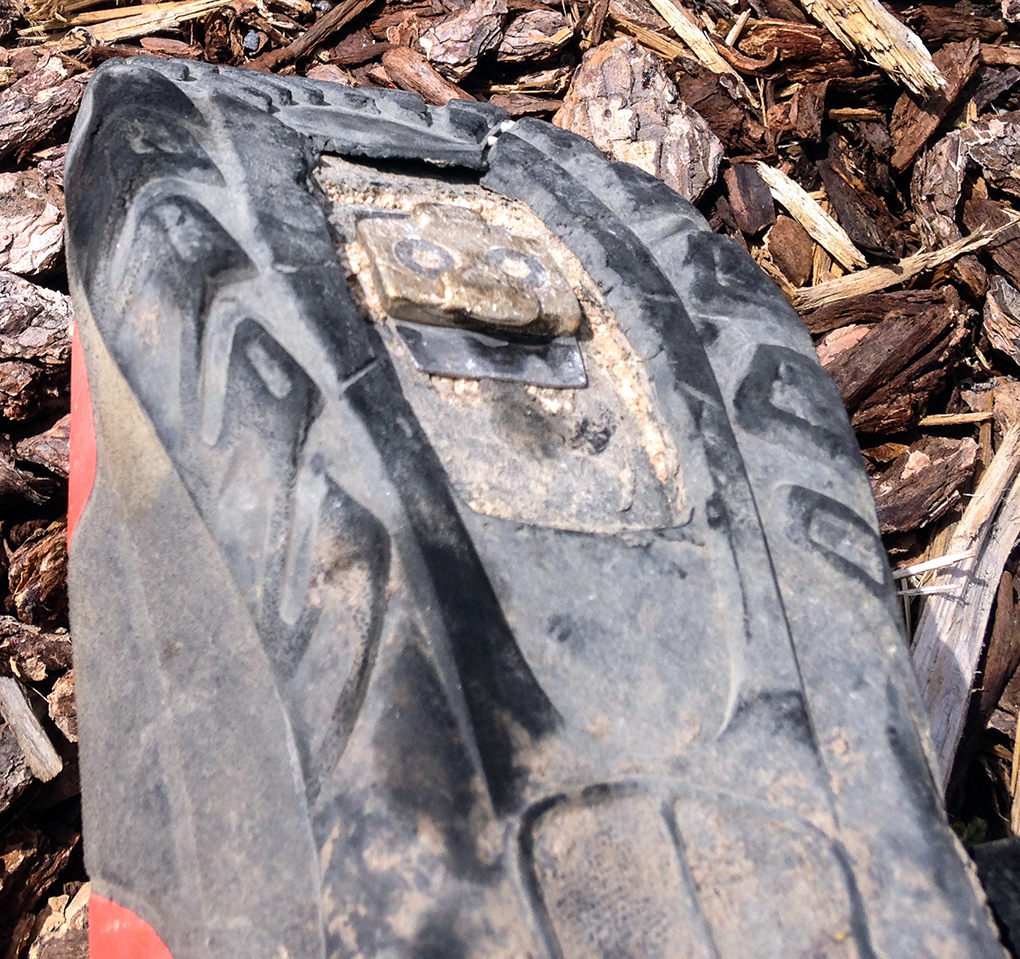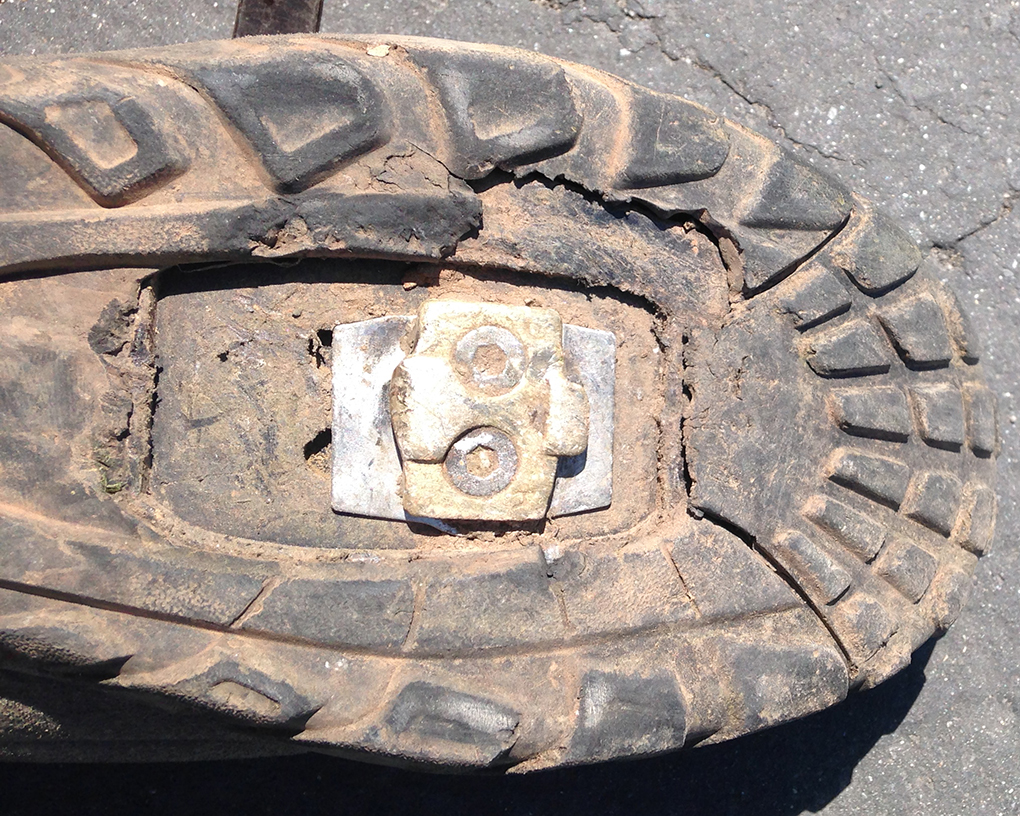Giro Terraduro Shoe

Upper: Breathable microfiber; Strong and secure MR-2 ratcheting buckle closure (replaceable); Offset strap “D-ring” at mid-foot; Rubber toe cap
Outsole: Molded SPD-compatible shank with optimized cleat zone; Full Vibram® High-traction lugged outsole; Flexible forefoot zone for walking
Footbed: Molded EVA footbed with medium arch support; Aegis® anti-microbial treatment
Size Tested: 46.5
Street Shoe: 11.5
Blister’s Measured Weight: 495 grams (per shoe)
Duration of test: 500+ miles over 2 pairs
Test Location: around the Wasatch, UT.
The Giro Terraduro was designed for all mountain riding, and (in Giros’s words), “balancing on- and off-the-bike performance in a low-profile design.”
I started riding in the Terraduro mid-summer last year after absolutely destroying a pair of carbon-soled shoes on a 2500ft vert hike-a-bike on a talus slope.
The Giro Terraduro features a full Vibram-wrapped sole with a flexible toe box and stiff shank from the ball of foot back to the heel.
Now that I have ridden them a ton, I have some positive and a few negative points to offer a prospective shopper on these shoes.
Pedal Performance
The Giro Terraduro has a stiff nylon shank under foot. The shank tapers and is highly flexible in the toe box. In the real world, I really don’t notice all that much difference between the Terraduro’s ability to drive the cranks under a hard effort vs. a carbon XC shoe, but the Terraduro feels notably stiffer than something like a Five Ten Maltese Falcon.
I would never competitively race XC in these shoes, but while mountain biking on trails, the responsiveness of the shoe was not too far off from my trusty Sidi Drako ultra pimp XC shoes.
Hiking Performance and Durability
The big selling point of the Terraduro is the rubber outsole and flex zone on the toe. These features boost allow the shoe to perform better when scrambling around on boulders and handle short, steep hike-a-bikes really well compared to a traditional stiff soled XC-style shoe. It’s way less sketchy, and in theory, the shoe will be much more durable after prolonged use on rocks.
While there is not a provision for toe spikes, the combination of sticky rubber and flexible toe box would make these a nice option for a dry condition cyclocross shoe.
Unfortunately, this design presented a significant durability issue for me. Within the first 300 miles of riding, and after only two longer, ~1500ft vert hike-a-bikes, the outsole of both shoes completely peeled off the shank, literally to the point that I could see a few toes sticking out of the side of the shoe each time I cornered the bike. The local shop where I had purchased the shoes was super cool and helpful, and traded me out for a new pair, no questions asked.
But unfortunately, despite no significant rock scrambling, the new shoes have already started showing separation of the sole from the shank.

It seems to me that the highly flexible toe portion of the shank is just too flexible compared to the heavy duty rubber outsole, and this difference in flex forces the sole to peel from the shank.
UPDATE: After 8 additional days of use with this shoe, the sole has completely died. The lateral portion of the shoe, at the metatarsal heads is no longer attached to the sole. This give a sketchy ride to say the least. I would like to go on record as stating that I would strongly suggest avoiding these shoes if you intend to do any walking on rough trail at all.
We contacted Giro about the issue and they confirmed that the initial run for the Terraduro did suffer from a manufacturing defect which has been fixed in more recent runs. They also linked us to this statement on the issue: http://www.giro.com/us_en/
We’ll be reviewing another pair soon and adding an update to determine if the newer version solves these durability issues.

Fit and Comfort
The shoes fit, all in all, pretty well. My size 11.5 street shoe fit is pretty true to size in a 46.5 shoe length wise. I did find the overall volume to be a little low, and could see some folks getting a size larger than normal if their foot is D width or just generally high volume (arch, mid-foot, etc) such as mine.
I run my cleats straight in line with the ball of my foot. With such an arrangement, my cleat position was about 2/3 of the way forward in the adjustment range. I would think it pretty unlikely many folks would go much more forward in the range, and there is a good 1.5cm or so to move the cleats backward.
Even with the Crank Brothers Shoe Shield, the cleat recessed nicely into the tread, and did not click around while walking on pavement. I prefer these steel reinforcement plates to protect the shoe’s shank from wear caused by the pedal, but also to help the cleat enter the pedal quicker. I never ride for more than 1 pedal stroke un-clicked.
The shoe’s upper ratchet strap effectively locks my heel back in the pocket. I would call the overall width a “C”.
And given my D-width feet, I did not need to apply much pressure from the lower or mid strap.
There is a molded rubber toe cap that is comparable to most XC-style shoes. I didn’t have any toe strike issues in the Terraduro, and rarely do with any shoe that I’ve used for its intended use. I could see racing DH in these shoes, but if you are riding very steep, loose and rocky trails with speed, I would look for something with a bit more rigidity at the front.
There are two points on the shoe’s Fit and Comfort that I have had problems with. The material in which it is constructed is very scuff resistant, but also minimally breathable, and it has no give or stretch to it. So I will be grabbing my XC shoes instead on hot summer days to give my feet some increased air-flow, and to allow my feet to swell slightly on longer rides. No matter how loose I strap the shoes, my D-width feet get cramps at the 2 hour mark of a ride.
Bottom Line
I certainly can’t say that you’ll have the same issues with the Terraduro that I have, and these shoes pedal so well that I continue to use them on rides that are (a) less than 2 hours, (b) aren’t super warm, or (c) where I know there might be some hike-a-bike.
Once the soles peel off again, they will go into the trash can, and I will search for a different pair of similarly designed shoes. If I cannot find a pair that is more breathable and pedals as well, I will probably purchase another set of these in a half size bigger to give my foot more space in them, and hope that corrects the issues I’ve had.
These are promising shoes that pedal great, and I would love to see a few tweaks come to the next generation of these shoes.
